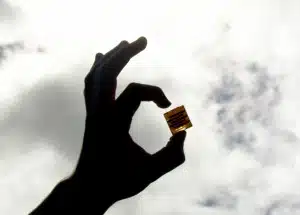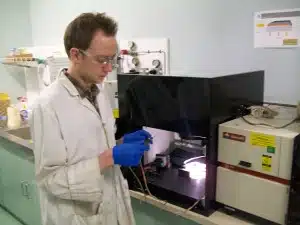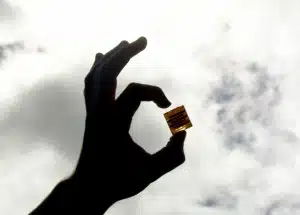Australian researchers have invented nanotech solar cells that are thin, flexible and use 1/100th the materials of conventional solar cells.
Printable, flexible solar cells that could dramatically decrease the cost of renewable energy have been developed by PhD student Brandon MacDonald in collaboration with his colleagues from CSIRO’s Future Manufacturing Flagship and the University of Melbourne’s Bio21 Institute.
Their patented technology is based on inks containing tiny, semiconducting nanocrystals, which can be printed directly onto a variety of surfaces.
By choosing the right combination of ink and surface it is possible to make efficient solar cells using very little material or energy.
“The problem with traditional solar cells,” Brandon says, “is that making them requires many complex and energy intensive steps.”
“Using nanocrystal inks, they can be manufactured in a continuous manner, which increases throughput and should make the cells much cheaper to produce.”
Nanocrystals, also known as quantum dots, are semiconducting particles with a diameter of a few millionths of a millimetre. Because of their extremely small size they can remain suspended in a solution.
This solution can then be deposited onto a variety of materials, including flexible plastics or metal foils. It is then dried to form a thin film.
Brandon and his colleagues discovered that by depositing multiple layers of nanocrystals they can fill in any defects formed during the drying process.
The result is a densely packed, uniform film, ideal for lightweight solar cells.
The nanocrystals consist of a semiconducting material called cadmium telluride, which is a very strong absorber of light. This means that the resulting cells can be made very thin.
“The total amount of material used in these cells is about 1% of what you would use for a typical silicon solar cell.
Even compared to other types of cadmium telluride cells ours are much thinner, using approximately one-tenth as much material,” Brandon says.
The technology is not limited to solar cells. It can also be used to make printable versions of other electronic devices, such as light emitting diodes, lasers or transistors.
For his work Brandon has received the 2010/11 DuPont Young Innovator’s Award and has had his work published in the journal Nano Letters.
Brandon MacDonald is one of 16 early-career scientists presenting their research to the public for the first time thanks to Fresh Science, a national program sponsored by the Australian Government.
His challenges included presenting his discoveries in verse at a Melbourne pub.
- For interviews contact Brandon MacDonald on 0450 620 107 or Brandon.Macdonald@csiro.au
- For CSIRO, contact Tracey Nicholls on (03) 9545 2960 or Tracey.Nicholls@csiro.au
- For University of Melbourne, contact Helen Varnavas on (03) 8344 2225 or varnavas@unimelb.edu.au
- For Fresh Science, contact Sarah Brooker on 0413 332 489 or AJ Epstein on 0433 339 141 or email Niall Byrne on niall@scienceinpublic.com.au








 Fresh Science is on hold for 2022. We will be back in 2023.
Fresh Science is on hold for 2022. We will be back in 2023.